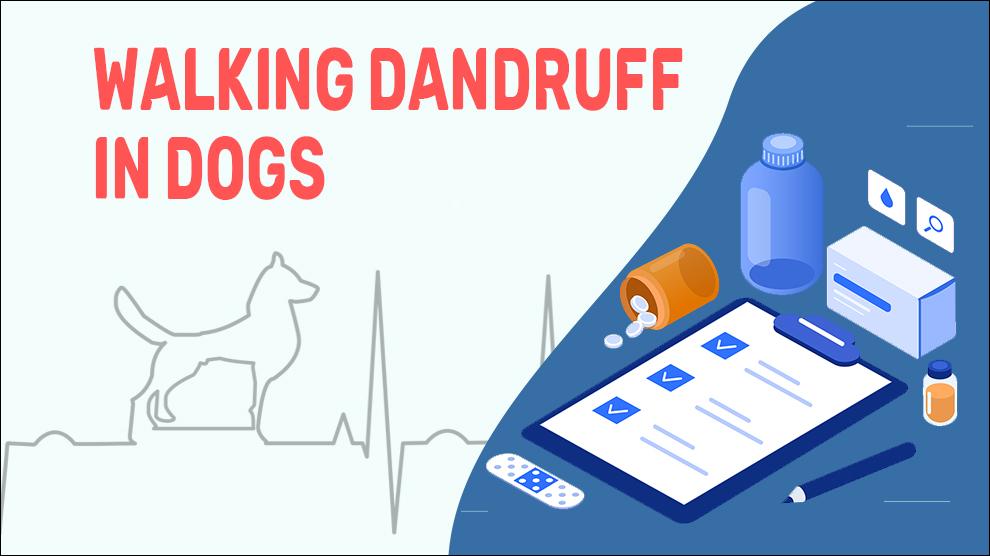What Is Walking Dandruff In Dogs?
Walking Dandruff (cheyletiellosis) is an uncommon but highly contagious skin parasite of dogs caused by Cheyletiella yasguri (Cheyletiella sp.) mites. These large, whitish mites crawl across skin and fur giving an appearance of dandruff moving around with excessive scaling (but they don’t jump like fleas) and so it is also called walking dandruff.
Usually, they hide into your dog’s skin and cause excessive scaling (scurf, dandruff), which gives the fur or coat a mealy or powdery look, particularly over the back side dorsal midline. Another familiar skin condition in dogs ‘mange’ is also caused by these mites. 'Walking dandruff’ affects the dogs from other infected pets at groomers/animal shelters/kennels/breeders or other areas where several dogs come in contact with one another.
Although Cheyletiella species mites are species-specific, they do transport easily from one host species to another and cross-infect humans as well. The Cheyletiella prevalence is worldwide and seems to be predominantly common in countries, where standard flea control programs with long-term antiparasitic products are not in practice.
'Walking dandruff’ infection is self-restricting, as humans are inadvertent hosts. Earlier, this condition is considered to be synonymous with the “itchy red bump” disease, a pruritic papular disorder of indecisive histogenesis that was initially reported in Florida. But now it is found to be papular dermatitis. Complete recovery from cheyletiellosis occurs within 2- 4 weeks after the pet is diagnosed, and properly treated and the environment has been cleared of mites.
Symptoms Of Walking Dandruff In Dogs
- Red, bumpy rash
- Scabies-like lesions
- Dandruff-like scales on the skin
- Hair loss
- Variable degree of Pruritusor itching
- Weight loss
- Itchy, red, or Tearing Eyes
- Nasal congestion and sneezing
Treatment Options For Walking Dandruff In Dogs
Topical products include:
- LymDyp/ LimePlus Dip - Scented lime sulfur concentrate applied every 1 week for 6 dips. Use as per directions mentioned on the label
- Ivermectin injection: Anti-parasite medication for both internal and external parasites. This is not used in Australian shepherds, collies, English sheepdogs, German shepherds, Skye terriers, etc
- Anti-Dandruff shampoo containing Selenium sulphide - Weekly once/ 4 weeks
Most spot-on products are also effective. Examples include:
- Selamectin (Revolution, Stronghold, Chanhold, Paradyne) Monthly once/ three months
- Moxidectin (ProHeart, Advantage Multi, Advocate)
- Fipronil (Barricade, Frontline, Effipro, Easyspot, Parastar, Sentry Fiproguard, Pronyl OTC, PetArmor, Spectra Sure)
Home Remedies For Walking Dandruff In Dogs
Ticks - Use Tick Tornado or the Tick Twister or Tick sprays
Remove Fleas - Use Nitenpyram (Capstar) or flea and tick shampoo or special flea combs
Swelling or inflammation found in the skin: Use a cold pack or compress or Frozen peas/corn/bag of frozen vegetables
Wounds in exposed areas: Baking soda and water paste. Don’t use it in thick fur
itching and inflammation: Calamine lotion/Aloe vera gel/Hydrocortisone
How To Prevent Walking Dandruff In Dogs?
- Consult with the pet experts about the best tick collars, oral medications, and spot-on treatments for the dog
- Outdoor dogs wandering in the lush forested pathways, tick-infested wooded areas, and feeding areas should be restricted
- After a walk outdoors, don’t forget to frisk your dog for any fleas or ticks – in the belly, chest, neck, ears, toes, and back
- A commercial ear flush or an apple cider vinegar mixed in the required amount of water and flush monthly
- For controlling mites and other parasites, there are medicated shampoos for pets specifically
- Hotspots for mites are bedding, pillows, carpets, curtains, mattresses, and upholstered furniture in your house. If you suspect a considerable infestation, rinse the garments in warm water (+125°) at least monthly once to kill dust mites
- Use special air filters that would effectively trap mites, dust, and skin cells such as Portable air purifiers, HEPA air purifiers, and ULPA Air Purifiers, and in the Heating, ventilation, and air conditioning system
- When the household dust mites have gone berserk, consult with experts for pesticides and commercial powders for dust mite control
Affected Dog Breeds Of Walking Dandruff
There is no breed disposition.
Causes And Prognosis For Walking Dandruff In Dogs
1. Causes:
Walking dandruff mites and their hosts:
- Small rabbits, volcano rabbits - Cheyletiella romerolagi
- Common rabbits - Cheyletiella parasitivorax
- Hares - Cheyletiella strandtmanni
- Cats - Cheyletiella blakei
- Dogs - Cheyletiella yasguri (surface mites)
2. Mortality:
There is no reported mortality due to ‘Walking dandruff’ infestation.
3. Diagnosis:
- Complete blood count
- Cutaneous cytology - the skin sample from the dog is examined microscopically
4. Prognosis:
Most cases of walking dandruff are treatable. immunocompromised Dogs will be much more susceptible to other diseases and conditions as well as relapses of dandruff.
When To See A Vet For Walking Dandruff In Dogs?
Contact your vet right away, if you notice any of the following:
- Red, bumpy rash
- Dandruff-like scales in the skin
Food Suggestions For Walking Dandruff In Dogs
- Start with a bland diet with three parts plain cooked rice + one part unseasoned, boiled, skinless, boneless chicken breast
- Reintroduce your dog's regular food into his diet gradually
- Provide ample sources of fresh water. Dogs may be dehydrated so water provision is mandatory
Conclusion
After treatments have begun a quick recovery can be assured for mild infestation. For severe infestation, it may take a longer time for your dog to recover.
Proper adherence to your veterinarian's treatment plan is mandatory. The medications may be continued even after recovery to break the mites’ life cycle so that dogs don't get it again from the same source.

















